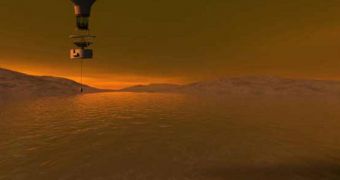Since July 1, 2004, the NASA Cassini orbiter has been keeping an eye on the Saturnine moon Titan, around which it already flew a number of passes. But what the probe has uncovered only managed to peak astronomers' interest, and so experts are now considering sending a blimp to the moon.
There are several reasons for why such a mission would be the ideal candidate for exploring Titan. When it comes to planetary exploration, scientists only have a small number of devices they can use.
These usually include rovers, landers and orbiters, but may also include blimps, balloons and airplanes. The selection of which type of robot to send is heavily dependent on the traits of the object that is the target of exploration.
One of the advantages that blimps have over any other type of explorer is the fact that it can remain airborne for months on end, covering massive swaths of land, and carrying large scientific payloads.
This is precisely what experts want to do on Titan, given that the moon has many points of interest on its surface. The frigid world contains lakes of liquid hydrocarbons at both its poles, as well as canyons, mountains, and a very thick atmosphere, which is mostly made up of nitrogen.
What researchers have yet to decide when it comes to exploring this space object is the exact type of probe they will use. The leading contender in this competition is a hot-air balloon/gondola combo.
This instrument would be powered by a radioisotope thermoelectric generator (RTG), which produces energy from the heat released by the decay of radioactive plutonium, or similar materials.
Electricity produced through this mechanism would be used to keep the balloon inflated, and also to power up the science suite on the gondola. An RTG would have a sufficiently-high output to enable a constant flight altitude of 6 miles (10 kilometers).
This type of spacecraft is the leading approach at this point because it has been detailed in the Titan Saturn System Mission (TSSM), which is a joint proposal of NASA and the European Space Agency.
The mission would include an orbiter, a lander and the balloon, and its launch has several years ago been set in 2020. However, in more recent developments, the flight has been indefinitely delayed.
“At present, I think the debate could be opened again,” explains Queen Mary University of London aerospace and aeronautical engineer Graham Dorrington.
Still, the expert agrees that the future mission needs to be a long-duration one, rather than a jet airplane, for example. For the costs associated with sending a mission to Titan, scientists and investors will need to justify every penny with useful information.
“If you consider cost per useful information bit, then long-endurance missions will pay,” Dorrington goes on to say, quoted by Space.

 14 DAY TRIAL //
14 DAY TRIAL //